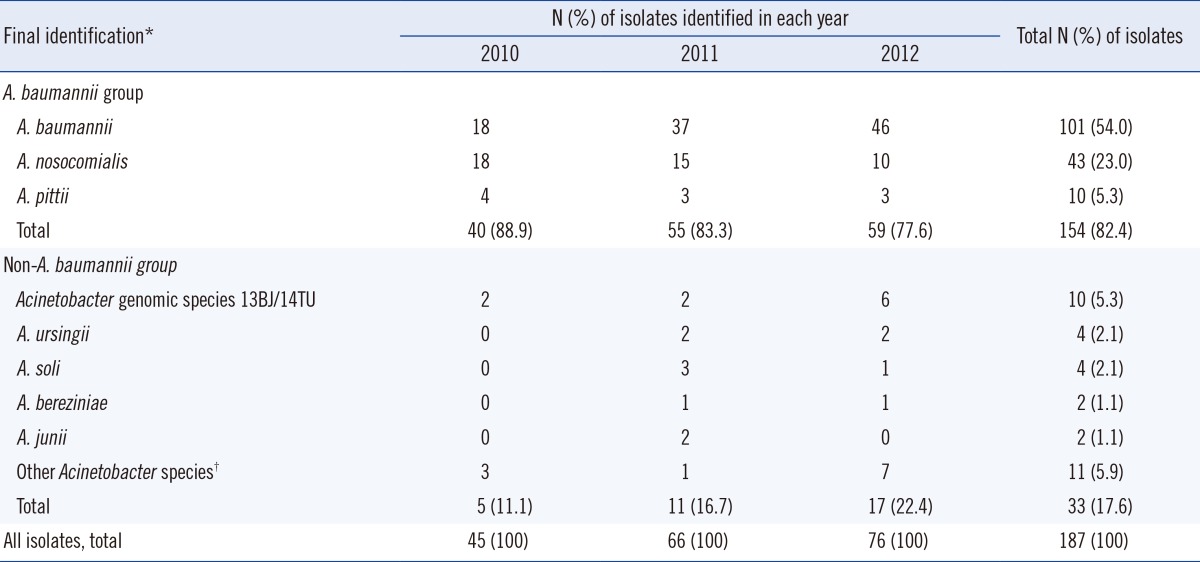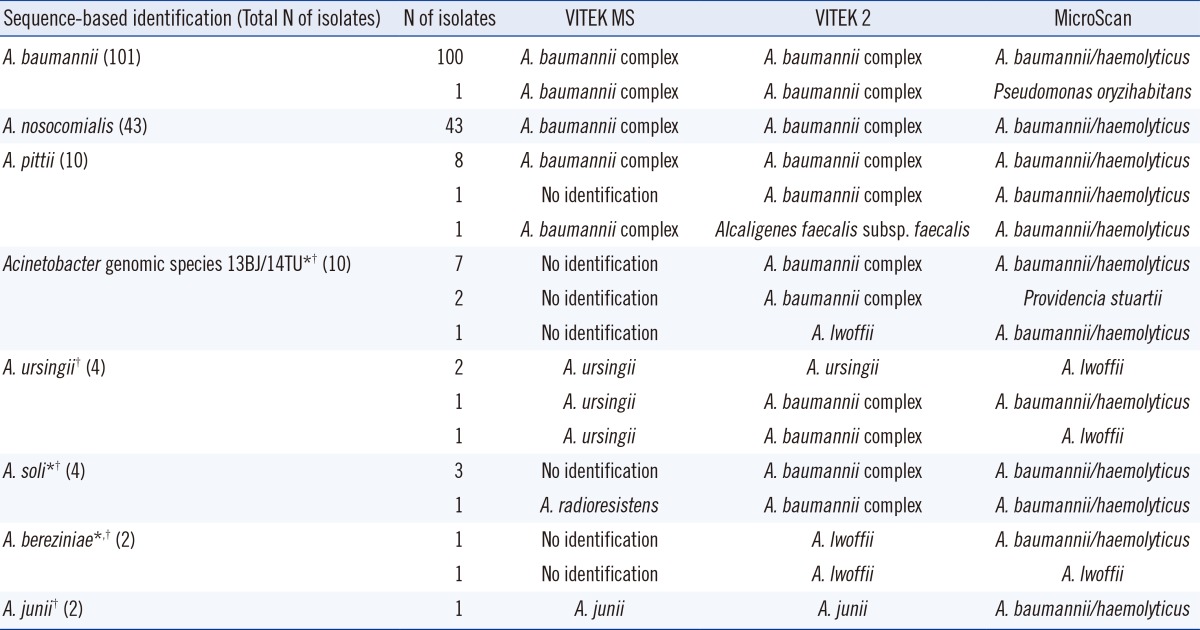1. Chuang YC, Sheng WH, Li SY, Lin YC, Wang JT, Chen YC, et al. Influence of genospecies of
Acinetobacter baumannii complex on clinical outcomes of patients with acinetobacter bacteremia. Clin Infect Dis. 2011; 52:352–360. PMID:
21193494.
2. Peleg AY, Seifert H, Paterson DL.
Acinetobacter baumannii: emergence of a successful pathogen. Clin Microbiol Rev. 2008; 21:538–582. PMID:
18625687.
3. Turton JF, Shah J, Ozongwu C, Pike R. Incidence of
Acinetobacter species other than
A. baumannii among clinical isolates of
Acinetobacter: evidence for emerging species. J Clin Microbiol. 2010; 48:1445–1449. PMID:
20181894.
4. Karah N, Haldorsen B, Hegstad K, Simonsen GS, Sundsfjord A, Samuelsen Ø. Species identification and molecular characterization of
Acinetobacter spp. blood culture isolates from Norway. J Antimicrob Chemother. 2011; 66:738–744. PMID:
21393175.
5. Dijkshoorn L, Nemec A, Seifert H. An increasing threat in hospitals: multidrug-resistant
Acinetobacter baumannii. Nat Rev Microbiol. 2007; 5:939–951. PMID:
18007677.
6. Kim D, Baik KS, Kim MS, Park SC, Kim SS, Rhee MS, et al.
Acinetobacter soli sp. nov., isolated from forest soil. J Microbiol. 2008; 46:396–401. PMID:
18758729.
7. Nemec A, Musílek M, Maixnerová M, De Baere T, van der Reijden TJ, Vaneechoutte M, et al.
Acinetobacter beijerinckii sp. nov. and
Acinetobacter gyllenbergii sp. nov., haemolytic organisms isolated from humans. Int J Syst Evol Microbiol. 2009; 59:118–124. PMID:
19126734.
8. Vaneechoutte M, De Baere T, Nemec A, Musílek M, van der Reijden TJ, Dijkshoorn L. Reclassification of
Acinetobacter grimontii Carr et al. 2003 as a later synonym of
Acinetobacter junii Bouvet and Grimont 1986. Int J Syst Evol Microbiol. 2008; 58:937–940. PMID:
18398198.
9. Wisplinghoff H, Paulus T, Lugenheim M, Stefanik D, Higgins PG, Edmond MB, et al. Nosocomial bloodstream infections due to
Acinetobacter baumannii,
Acinetobacter pittii and
Acinetobacter nosocomialis in the United States. J Infect. 2012; 64:282–290. PMID:
22209744.
10. Kishii K, Kikuchi K, Matsuda N, Yoshida A, Okuzumi K, Uetera Y, et al. Evaluation of matrix-assisted laser desorption ionization-time of flight mass spectrometry for species identification of
Acinetobacter strains isolated from blood cultures. Clin Microbiol Infect. 2014; 20:424–430. PMID:
24125498.
11. Lee SY, Shin JH, Park KH, Kim JH, Shin MG, Suh SP, et al. Identification, genotypic relation, and clinical features of colistin-resistant isolates of
Acinetobacter genomic species 13BJ/14TU from bloodstreams of patients in a university hospital. J Clin Microbiol. 2014; 52:931–939. PMID:
24403305.
12. Lee YC, Huang YT, Tan CK, Kuo YW, Liao CH, Lee PI, et al.
Acinetobacter baumannii and
Acinetobacter genospecies 13TU and 3 bacteraemia: comparison of clinical features, prognostic factors and outcomes. J Antimicrob Chemother. 2011; 66:1839–1846. PMID:
21653602.
13. Lee K, Yong D, Jeong SH, Chong Y. Multidrug-resistant
Acinetobacter spp.: increasingly problematic nosocomial pathogens. Yonsei Med J. 2011; 52:879–891. PMID:
22028150.
14. Bernards AT, van der Toorn J, van Boven CP, Dijkshoorn L. Evaluation of the ability of a commercial system to identify
Acinetobacter genomic species. Eur J Clin Microbiol Infect Dis. 1996; 15:303–308. PMID:
8781881.
15. Dubois D, Grare M, Prere MF, Segonds C, Marty N, Oswald E. Performances of the Vitek MS matrix-assisted laser desorption ionization-time of flight mass spectrometry system for rapid identification of bacteria in routine clinical microbiology. J Clin Microbiol. 2012; 50:2568–2576. PMID:
22593596.

16. Manji R, Bythrow M, Branda JA, Burnham CA, Ferraro MJ, Garner OB, et al. Multi-center evaluation of the VITEK® MS system for mass spectrometric identification of non-
Enterobacteriaceae Gram-negative bacilli. Eur J Clin Microbiol Infect Dis. 2014; 33:337–346. PMID:
24019163.
17. Khamis A, Raoult D, La Scola B.
rpoB gene sequencing for identification of
Corynebacterium species. J Clin Microbiol. 2004; 42:3925–3931. PMID:
15364970.
18. La Scola B, Gundi VA, Khamis A, Raoult D. Sequencing of the
rpoB gene and flanking spacers for molecular identification of
Acinetobacter species. J Clin Microbiol. 2006; 44:827–832. PMID:
16517861.
19. Gundi VA, Dijkshoorn L, Burignat S, Raoult D, La Scola B. Validation of partial
rpoB gene sequence analysis for the identification of clinically important and emerging
Acinetobacter species. Microbiology. 2009; 155:2333–2341. PMID:
19389786.
20. Won EJ, Shin JH, Lee K, Kim MN, Lee HS, Park YJ, et al. Accuracy of species-level identification of yeast isolates from blood cultures from 10 university hospitals in South Korea by use of the matrix-assisted laser desorption ionization-time of flight mass spectrometry-based Vitek MS system. J Clin Microbiol. 2013; 51:3063–3065. PMID:
23784123.

21. Gerner-Smidt P, Tjernberg I, Ursing J. Reliability of phenotypic tests for identification of
Acinetobacter species. J Clin Microbiol. 1991; 29:277–282. PMID:
2007635.
22. Seifert H, Strate A, Schulze A, Pulverer G. Bacteremia due to
Acinetobacter species other than
Acinetobacter baumannii. Infection. 1994; 22:379–385. PMID:
7698833.
23. Wareham DW, Bean DC, Khanna P, Hennessy EM, Krahe D, Ely A, et al. Bloodstream infection due to
Acinetobacter spp: epidemiology, risk factors and impact of multi-drug resistance. Eur J Clin Microbiol Infect Dis. 2008; 27:607–612. PMID:
18283503.
24. Šedo O, Nemec A, Křížová L, Kačalová M, Zdráhal Z. Improvement of MALDI-TOF MS profiling for the differentiation of species within the
Acinetobacter calcoaceticus-Acinetobacter baumannii complex. Syst Appl Microbiol. 2013; 36:572–578. PMID:
24054697.





 PDF
PDF ePub
ePub Citation
Citation Print
Print




 XML Download
XML Download